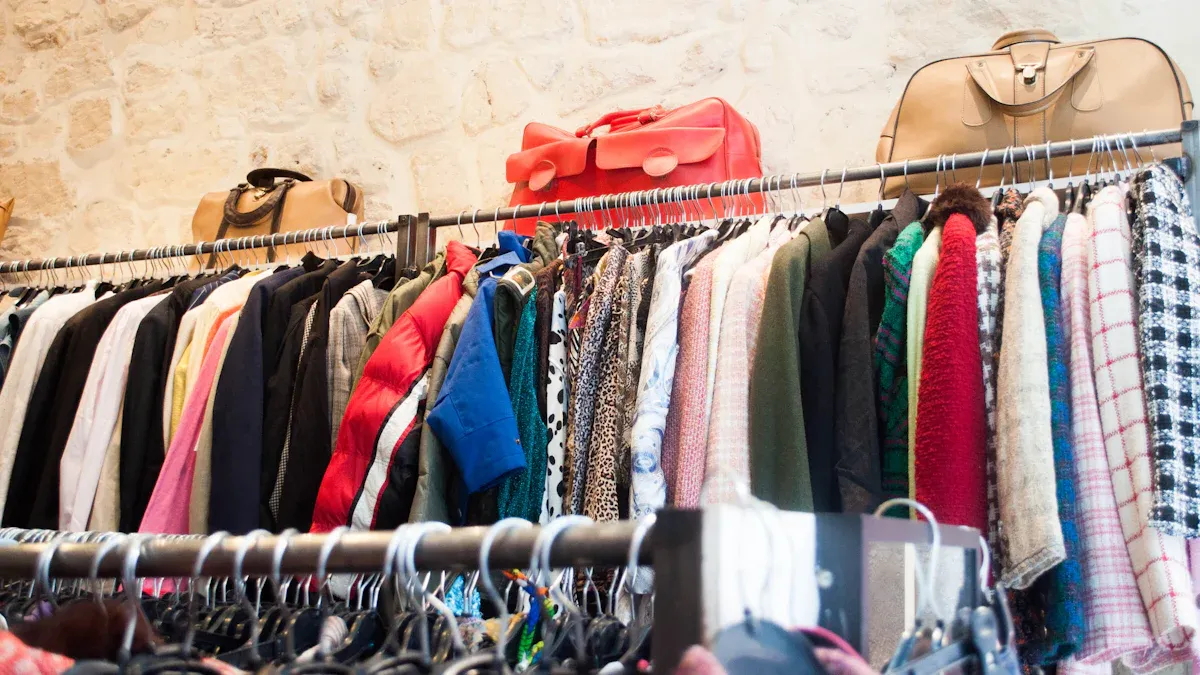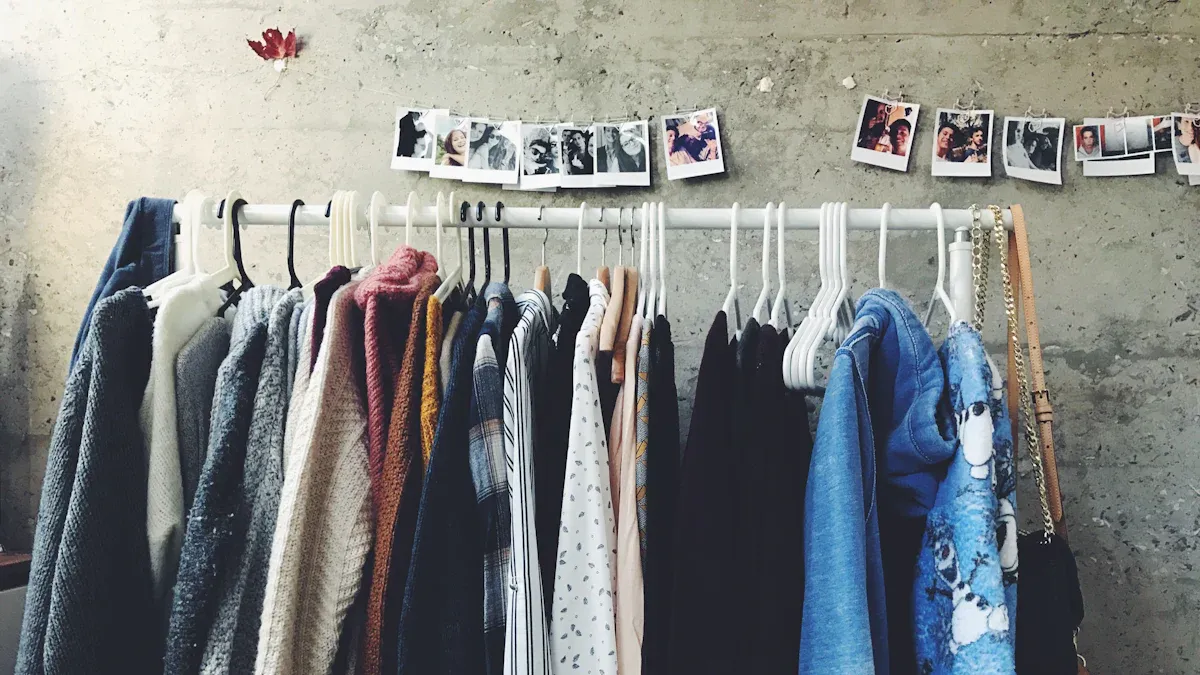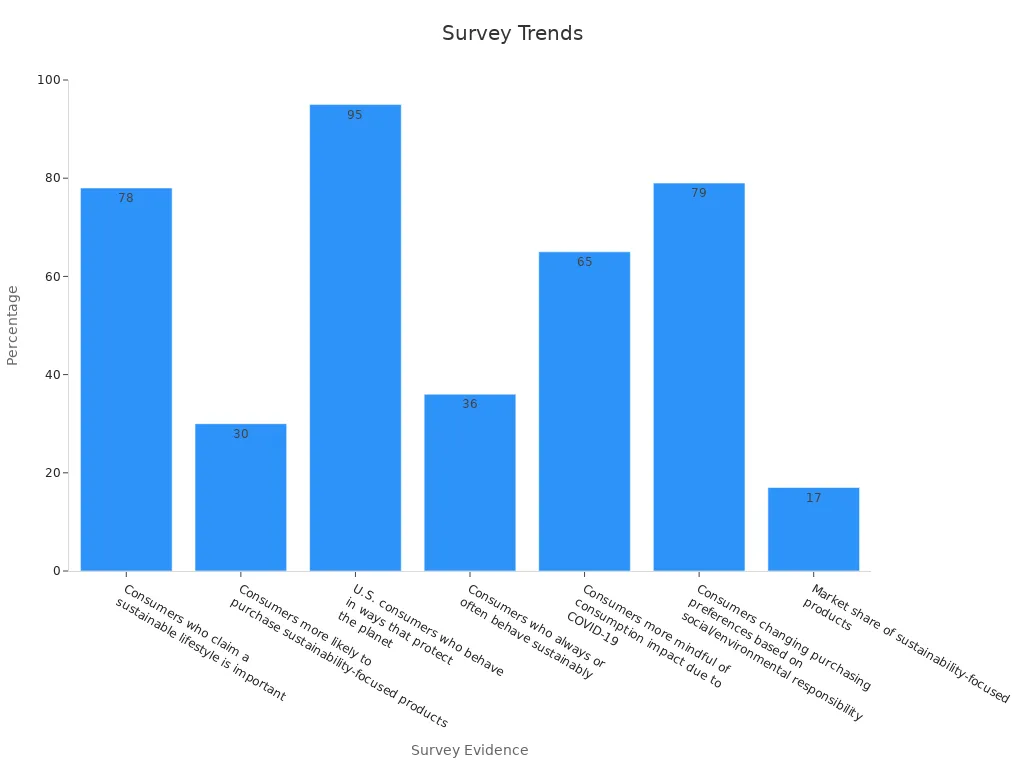How Pre-Owned Fashion Supports Sustainability
Have you ever thought about where your clothes go after you're done with them? Fast fashion churns out so much clothing that every second, a truckload of textiles ends up in landfills. That adds up to 92 million tons of waste every year! Pre-owned fashion offers a smarter, eco-friendly approach to this problem. By extending the life of garments, it reduces waste, saves resources, and helps combat the environmental toll of fast fashion. For example, wearing clothes longer—even just three extra months—can cut their carbon and water footprint by up to 10%. It’s a small change with a big impact on sustainability.
Choosing pre-owned fashion isn’t just about saving money; it’s about taking part in sustainability initiatives. It’s an easy way for you to embrace an eco-friendly lifestyle without giving up style.
Key Takeaways
Buying used clothes helps cut down on fabric waste. Each secondhand item keeps clothing out of trash dumps.
Wearing clothes longer, even by a few months, lowers pollution and saves water. Small actions can make a big difference.
Secondhand shopping helps small businesses and supports recycling. Your choices help your community and the planet.
Thrifting and reusing clothes save money and help the Earth. Fixing or changing old clothes reduces trash and adds style.
Choosing eco-friendly fashion is becoming more popular. By buying used clothes, you support green values and help the environment.
The Environmental Costs of Fast Fashion

Fast fashion might seem convenient, but its environmental impact is anything but. From draining natural resources to polluting ecosystems, the industry leaves a heavy footprint on the planet. Let’s break down the costs.
Resource Depletion in Clothing Production
Did you know that making a single cotton shirt uses about 700 gallons of water? That’s enough to keep one person hydrated for nearly three years! Producing a pair of jeans takes even more—around 2,000 gallons. Cotton farming, which supports much of the fashion industry, is one of the largest contributors to freshwater withdrawal and ecosystem degradation.
On top of that, the average American generates 82 pounds of textile waste annually. This highlights how fast fashion drives decreased resource consumption by encouraging disposable clothing habits. Every new garment adds to the strain on our planet’s limited resources, making it clear that the industry’s production methods are unsustainable.
Pollution and Greenhouse Gas Emissions
Fast fashion doesn’t just deplete resources—it also pollutes the environment. The industry contributes to about 10% of global carbon dioxide emissions, releasing 1.2 billion tonnes of CO2 equivalent each year. Textile purchases in the EU alone resulted in 270 kg of CO2 emissions per person in 2020.
The environmental impact goes beyond greenhouse gases. Harmful chemicals and microplastics from textile production end up in waterways, damaging aquatic ecosystems. These pollutants degrade habitats and worsen climate change, making fast fashion a major contributor to environmental harm.
The Growing Problem of Textile Waste
The waste generated by fast fashion is staggering. Globally, 92 million tons of textile waste are produced annually, with China contributing 20 million tons and the US adding 17 million tons. Shockingly, 87% of these materials end up in incinerators or landfills, while only 1% are recycled into new garments.
Statistic | Value |
|---|---|
Global textile waste produced annually | 92 million tons |
Percentage of materials ending up in incinerators or landfills | 87% |
Percentage of clothes recycled into new garments | 1% |
Annual plastic waste generated by textile production | 42 million tons |
This waste doesn’t just take up space—it contributes to microplastic pollution and environmental degradation. With clothing sales projected to reach 160 million tons by 2050, the problem is only growing. Choosing pre-owned fashion can help reduce this waste and lessen the environmental impact.
Environmental Benefits of Pre-Owned Fashion

When you choose pre-owned fashion, you're doing more than just saving money—you’re making a real difference for the planet. By giving garments a second life, you help reduce waste, conserve resources, and lower the environmental impact of your wardrobe. Let’s explore how this sustainable practice benefits the environment.
Extending the Life Cycle of Clothing
Every time you wear a secondhand piece, you’re extending the life of that garment. This simple act has a profound impact on sustainability. Studies show that extending the life cycle of clothing—by wearing items longer and washing them less frequently—can cut environmental impacts by up to 75%. That’s because it reduces the need for new production, which is a major driver of greenhouse gas emissions, energy use, and water consumption.
Brands are also stepping up to encourage this practice. For example:
Patagonia’s Worn Wear program repairs and resells used gear, promoting reuse.
Levi’s SecondHand program refurbishes old jeans for resale.
H&M’s take-back initiative sorts unwanted clothing for resale or recycling.
These programs show how extending the life of garments can become a shared responsibility between consumers and brands. By choosing secondhand, you’re not just buying clothes—you’re supporting sustainable practices that prioritize the planet.
Reducing Carbon Footprint and Water Usage
Did you know that reusing just 1 kilogram of clothing saves 25 kilograms of CO2? That’s a huge win for the environment. Secondhand shopping reduces the demand for new production, which is one of the most resource-intensive processes in the fashion industry. For instance, producing a single cotton shirt uses about 700 gallons of water, while a pair of jeans requires around 2,000 gallons. By opting for reused clothing, you help conserve these precious resources.
Even small changes can make a big difference. Extending the lifespan of garments by just nine months can lower their carbon, water, and waste footprints by 20-30%. Imagine the collective impact if more people embraced secondhand fashion. A 10% increase in secondhand sales could save 3% of global carbon emissions and 4% of water usage. These numbers highlight how your choices can contribute to a more sustainable future.
Minimizing Landfill Waste
Fast fashion has created a massive waste problem, with 92 million tons of textiles discarded annually. Most of this waste ends up in landfills, where it contributes to pollution and releases harmful greenhouse gases. Pre-owned fashion offers a solution by keeping clothes in circulation longer and out of the trash.
For every 100 used garments purchased, 60-85 new garments are displaced. This displacement significantly reduces the need for new production, which often involves toxic chemicals and unsustainable practices. By choosing secondhand, you’re not only reducing textile waste but also helping to prevent the environmental damage caused by producing new clothes.
The ripple effect of these choices is undeniable. When you buy secondhand, you’re part of a movement that prioritizes sustainability over disposability. Together, we can tackle the growing problem of textile waste and create a cleaner, greener planet.
Economic and Social Impact of Secondhand Shopping
Second-hand shopping isn’t just good for the environment—it’s a game-changer for local economies and communities. By choosing secondhand, you’re supporting small businesses, encouraging sustainable practices, and making fashion more accessible for everyone.
Supporting Local Communities and Small Businesses
When you shop at thrift stores or buy from local second-hand sellers, you’re directly contributing to your community. These businesses thrive on your support, creating jobs and fostering economic growth. The resale industry is booming, and it’s not slowing down anytime soon.
A study highlights that shifting from a throw-away culture to reusing clothing can boost high-quality fashion development and provide economic value to society. It also emphasizes that promoting second-hand clothing reuse benefits local communities through better engagement and sustainable practices.
Here’s how the numbers stack up:
Statistic | Value |
|---|---|
Resale industry growth compared to retail clothing sector | |
Retail leaders indicating customer interest in resale | 86% (8 points higher than 2021) |
Retailers planning to increase resale investments | About 2 out of 3 retailers |
The rise of online resale platforms has also helped hundreds of small businesses specializing in secondhand goods grow. Every purchase you make in the second-hand clothing market strengthens these businesses and supports a more sustainable economy.
Promoting a Circular Economy
Second-hand shopping plays a vital role in building a circular economy. Instead of discarding clothes, you’re keeping them in circulation, reducing waste, and lowering the environmental impact of fashion. The resale market for secondhand fashion has grown 21 times faster than retail over the past five years. That’s a clear sign that more people are embracing this sustainable approach.
Brands like Patagonia are leading the way by repairing and reselling used items. Their repair facilities handle about 50,000 pieces annually, proving that second-hand fashion isn’t just a trend—it’s a movement toward sustainability. By participating in this circular economy, you’re helping to create a system where resources are reused, not wasted.
Making Sustainable Fashion Affordable
One of the best things about second-hand shopping is how affordable it makes sustainable fashion. You don’t have to break the bank to make eco-friendly choices. Reusing preloved items displaces 17.4 lbs of CO2 emissions per piece. Plus, consuming second-hand clothing reduces your carbon footprint by 82% compared to buying new.
Thrifting also offers a practical way to reduce greenhouse gas emissions. Clothes swapping, for example, is a fun and budget-friendly way to refresh your wardrobe while staying sustainable. By choosing second-hand, you’re proving that sustainability and affordability can go hand in hand.
Encouraging Sustainable Consumer Habits
Sustainability starts with the choices you make every day. By shifting your mindset and embracing sustainable consumption practices, you can reduce your environmental impact while still enjoying fashion. Let’s explore how you can make a difference by adopting conscious habits.
Shifting Toward Conscious Consumption
Have you ever stopped to think about the environmental impact of your shopping habits? Many people are now doing just that. Living through a global pandemic has made us more aware of how our daily choices affect the planet. This shift has sparked a growing demand for products that align with sustainability values.
Global online searches for sustainable goods have skyrocketed by 71% in the last five years.
72% of consumers now buy more eco-friendly products than they did five years ago.
55% of shoppers are even willing to pay more for brands that prioritize sustainability.
These numbers show that environmentally conscious consumers are on the rise. People are no longer just buying products—they’re making sustainable choices that reflect their values. By choosing pre-owned fashion, you can join this movement and help reduce the demand for new clothing. It’s a simple yet powerful way to align your wardrobe with your commitment to sustainability.
Embracing Thrifting, Repair, and Upcycling
Thrifting isn’t just a trend—it’s a lifestyle. When you shop secondhand, you’re not only saving money but also giving clothes a second chance. The U.S. secondhand market has grown by an impressive 117% since 2018, with resale surging by 550%. This boom shows how thrifting has become a go-to option for those who want to look good while doing good.
But thrifting is just the beginning. Repair and upcycling are equally important in creating a sustainable wardrobe. Instead of tossing out a torn shirt or worn-out jeans, why not fix them? Repairing your clothes extends their life and reduces waste. Plus, it’s a great way to embrace repair and upcycling as part of your sustainable consumption practices.
Upcycling takes things a step further by transforming old items into something new and unique. For example, you could turn an oversized shirt into a trendy crop top or repurpose denim scraps into a stylish tote bag. These creative projects not only reduce waste but also let you express your personal style in a way that’s truly one-of-a-kind.
Tip: Join local repair workshops or online upcycling communities to learn new skills and connect with like-minded individuals. It’s a fun and rewarding way to embrace sustainability.
Choosing Secondhand Over Fast Fashion
Fast fashion might seem convenient, but it comes at a high cost to the environment. By choosing secondhand shopping, you can break free from the cycle of disposable clothing and make a real impact. Did you know that buying pre-loved items reduces the demand for new production? This simple act helps lower carbon emissions and conserve water.
You’re not alone in this shift. A Harris Poll survey found that 68% of young consumers purchased secondhand clothing in the past year. While some are drawn to the affordability and unique styles of secondhand fashion, the environmental benefits are undeniable. Every secondhand purchase keeps clothes out of landfills and supports a circular economy where resources are reused instead of wasted.
The future of fashion is secondhand. According to a 2024 Resale Report by ThredUp, the secondhand clothing market is expected to nearly double by 2027. Younger generations, especially Gen Z, are leading this change. They’re embracing online resale platforms and proving that sustainable fashion can be stylish, affordable, and accessible.
Callout: Remember, when you buy second, buy conscience. Every secondhand purchase is a step toward a more sustainable future.

By shifting toward conscious consumption, embracing repair and upcycling, and choosing secondhand over fast fashion, you’re not just following a trend—you’re making a statement. Together, we can create a world where sustainable fashion is the norm, not the exception.
Pre-owned fashion is more than just a trend—it’s a powerful way to support sustainability and make a difference. By choosing secondhand clothing, you help reduce waste, conserve resources, and lower your carbon footprint. For instance, reusing garments saves 19 billion gallons of water annually and diverts 21 billion pounds of clothing from landfills. It’s a simple choice with a massive impact.
You’re also contributing to a circular economy where clothes are reused instead of discarded. This shift not only benefits the planet but also makes sustainable fashion more accessible and affordable for everyone. Together, we can create a future where style and sustainability go hand in hand.
FAQ
What is pre-owned fashion?
Pre-owned fashion refers to clothing, shoes, and accessories that have been previously owned and are now being resold. These items are often in excellent condition and offer a sustainable alternative to buying new, helping reduce waste and conserve resources.
How does buying secondhand help the environment?
When you buy secondhand, you extend the life of clothing, reducing the demand for new production. This saves water, energy, and raw materials while keeping textiles out of landfills. It’s a simple way to lower your carbon footprint and support sustainability.
Is secondhand shopping affordable?
Absolutely! Secondhand shopping is often much cheaper than buying new. You can find high-quality, stylish pieces at a fraction of the cost. Plus, it’s a great way to access luxury brands without breaking the bank.
Can secondhand clothes be stylish?
Yes! Secondhand fashion offers unique, vintage, and trendy pieces that help you stand out. Many pre-owned items are timeless classics or rare finds, making it easy to create a stylish and personalized wardrobe.
How do I start shopping for pre-owned fashion?
Start by exploring trusted resale platforms like PlushPast or visiting local thrift stores. Look for well-maintained items and focus on quality over quantity. You’ll discover amazing pieces while supporting a more sustainable and conscious way of shopping.
Redefining Luxury Through Conscious Style
In a world increasingly defined by speed and disposability, there’s something quietly radical about slowing down, and choosing to value what already exists. Pre-loved luxury isn’t just about extending the life of a beautiful garment; it’s about honoring the craftsmanship and intention that went into its creation. At its heart, sustainable fashion invites us to rethink what we truly treasure in our wardrobes: not fleeting trends, but pieces that carry a story, that feel personal, that last. This is the essence of timeless style, where beauty and ethics intersect. By curating pre-owned pieces with care and purpose, platforms like PlushPast are helping to reshape the meaning of luxury, inviting us to shop more consciously, live more intentionally, and dress with a deeper sense of connection.
Disclaimer:
The information on www.plushpast.com is for general information only. It is not professional, financial, or expert advice, and it should not be treated as such. PlushPast does not provide guidance on craftsmanship, heritage, or financial decisions. We recommend consulting a qualified expert for advice tailored to your specific needs before making any decisions. PlushPast is not responsible for any actions taken based on the content found on this website.